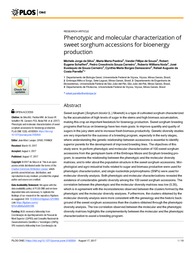Phenotypic and molecular characterization of sweet sorghum accessions for bioenergy production.
Phenotypic and molecular characterization of sweet sorghum accessions for bioenergy production.
Author(s): SILVA, M. J. da; PASTINA, M. M.; SOUZA, V. F. de; SCHAFFERT, R. E.; CARNEIRO, P. C. S.; NODA, R. W.; CARNEIRO, J. E. de S.; DAMASCENO, C. M. B.; PARRELLA, R. A. da C.
Summary: Sweet sorghum [Sorghum bicolor (L.) Moench] is a type of cultivated sorghum characterized by the accumulation of high levels of sugar in the stems and high biomass accumulation, making this crop an important feedstock for bioenergy production. Sweet sorghum breeding programs that focus on bioenergy have two main goals: to improve quantity and quality of sugars in the juicy stem and to increase fresh biomass productivity. Genetic diversity studies are very important for the success of a breeding program, especially in the early stages, where understanding the genetic relationship between accessions is essential to identify superior parents for the development of improved breeding lines. The objectives of this study were: to perform phenotypic and molecular characterization of 100 sweet sorghum accessions from the germplasm bank of the Embrapa Maize and Sorghum breeding program; to examine the relationship between the phenotypic and the molecular diversity matrices; and to infer about the population structure in the sweet sorghum accessions. Morphological and agro-industrial traits related to sugar and biomass production were used for phenotypic characterization, and single nucleotide polymorphisms (SNPs) were used for molecular diversity analysis. Both phenotypic and molecular characterizations revealed the existence of considerable genetic diversity among the 100 sweet sorghum accessions. The correlation between the phenotypic and the molecular diversity matrices was low (0.35), which is in agreement with the inconsistencies observed between the clusters formed by the phenotypic and the molecular diversity analyses. Furthermore, the clusters obtained by the molecular diversity analysis were more consistent with the genealogy and the historic background of the sweet sorghum accessions than the clusters obtained through the phenotypic diversity analysis. The low correlation observed between the molecular and the phenotypic diversity matrices highlights the complementarity between the molecular and the phenotypic characterization to assist a breeding program.
Publication year: 2017
Types of publication: Journal article
Unit: Embrapa Maize & Sorghum
Keywords: Bioenergia, Seleção fenotípica, Sorgo açucareiro
Observation
Some of Embrapa's publications are published as ePub files. To read them, use or download one of the following free software options to your computer or mobile device. Android: Google Play Books; IOS: iBooks; Windows and Linux: Calibre.
Access other publications
Access the Agricultural Research Database (BDPA) to consult Embrapa's full library collection and records.
Visit Embrapa Bookstore to purchase books and other publications sold by Embrapa.

